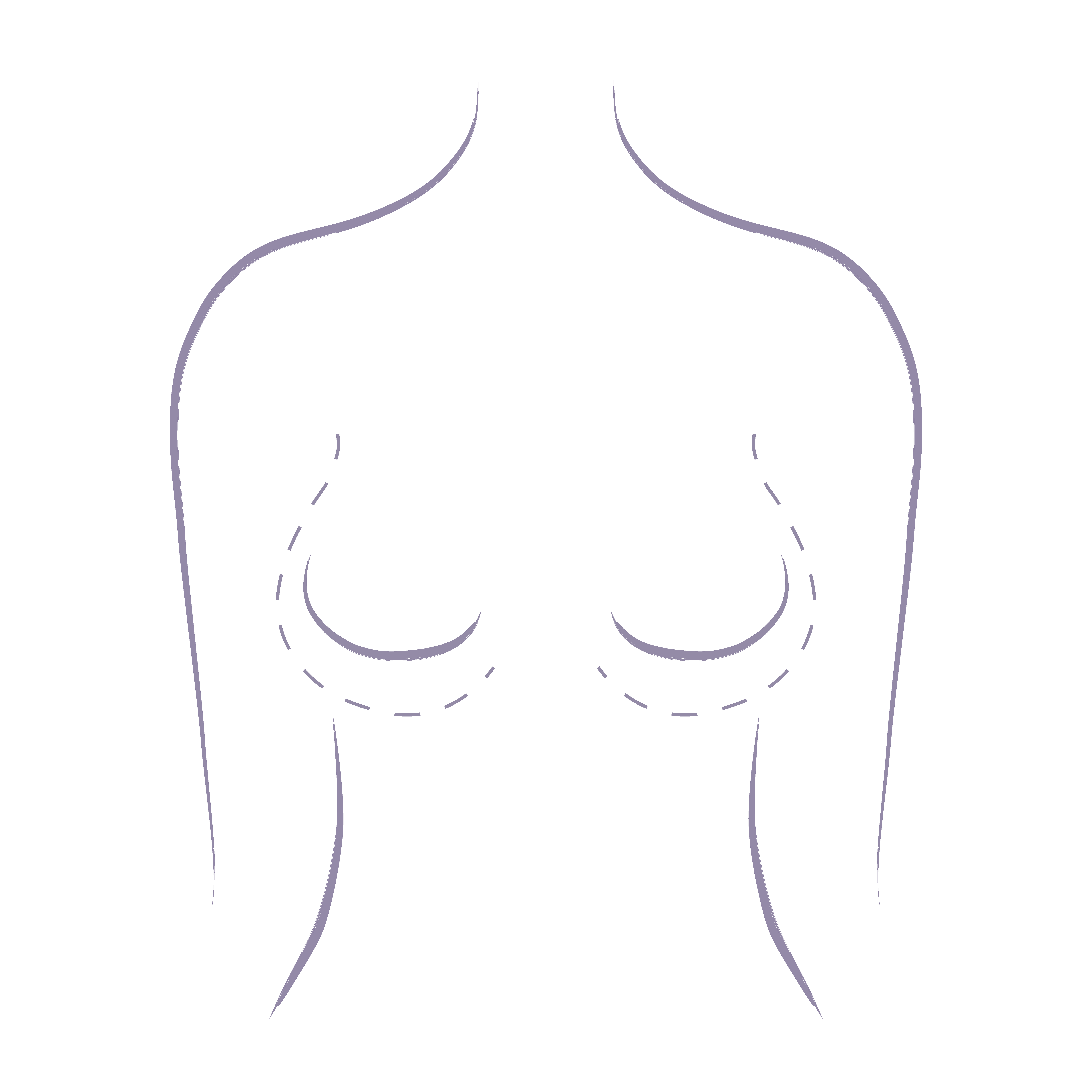Choosing the ideal breast implant size from the various breast implant sizes available is essential to breast augmentation, as it ensures the results are proportionate and align with each patient’s anatomy. Implant size involves several considerations, including volume, projection, and body structure.
This guide provides comprehensive, up-to-date information on implant sizing, helping patients understand what factors contribute to optimal outcomes. By addressing common sizing concerns and offering insight into Me Clinic’s personalised approach, this guide aims to assist patients in making informed decisions under the guidance of specialist plastic surgeons.
The Basics of Breast Implants
Breast implants are medical devices designed to enhance the size, shape, and overall appearance of the breasts. They are commonly used in breast augmentation surgery to restore lost volume, improve breast contours, and boost self-confidence.
Typically, breast implants consist of a durable silicone outer shell filled with either saline solution or silicone gel. The choice between saline and silicone implants depends on factors such as desired feel, appearance, and personal preference.
![]()
Many patients in the beginning believe size is the only factor that impacts the results of a breast augmentation. However there are many other choices and considerations for breast implants outside of the implant size that can change the aesthetics of your breasts.
Breast Implant Size Considerations
Breast implant size refers to the overall volume and dimensions of the implant, which affect the final appearance and fit. Implant size involves several considerations, including volume, projection, and body structure, to achieve the desired breast size. Implants are designed to enhance the breast’s shape, projection, and volume, with the size determined by key factors such as cubic centimetres (cc), implant width, and profile.
Understanding these elements ensures that the chosen implant complements the body’s proportions while achieving the desired aesthetic outcome.
Implant Size Measurements
Breast implant size is primarily measured in cubic centimeters (cc), representing the volume of the implant. Smaller implants typically range from 125cc to 250cc, while larger implants can exceed 800cc. The diameter, or width, of the implant, also known as the breast implant diameter, plays a critical role in determining how well it fits the chest wall. Implants with the right width prevent issues like improper fit or visible implant edges.
- Cubic Centimeters (cc): The volume of the implant.
- Diameter: The width of the implant measured across its widest point.
- Projection: The outward projection from the chest wall.
Selecting the correct combination of volume, diameter, and projection is essential for achieving proportionate and natural results.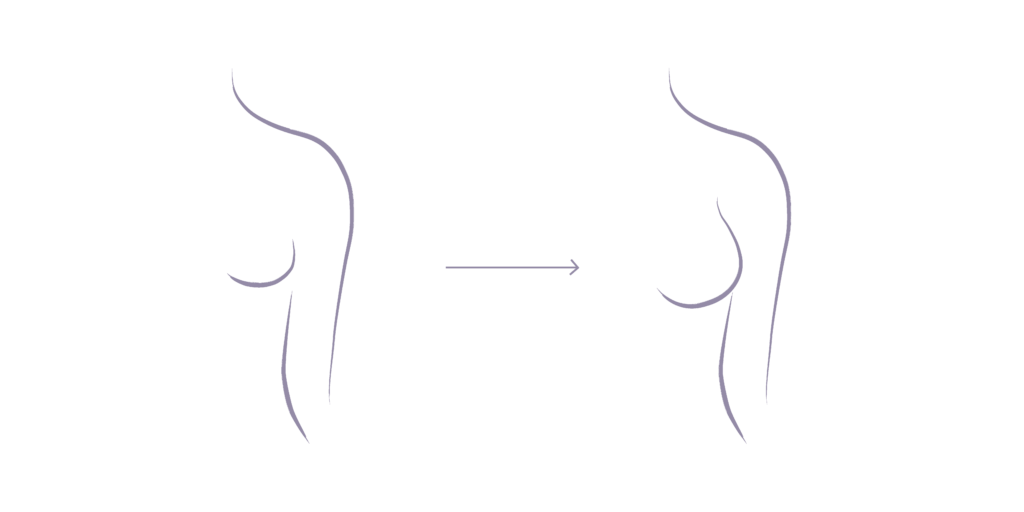
Implant Size Range
Breast implants come in various size ranges to suit different preferences and body types. Common categories include:
- Small implants are typically 125cc to 250cc, ideal for subtle volume enhancement or petite frames.
- Average-sized implants are between 300cc and 450cc, often chosen for natural, proportional augmentation.
- Large implants are 500cc and above, creating more noticeable fullness and projection.
- Very large implants (600cc+) are less common and are typically selected by patients seeking a more dramatic transformation. The largest breast implant size, typically 800cc or more, is chosen by patients seeking a dramatic transformation and is subject to FDA regulations.
Choosing the right size ensures the implant complements the body without causing complications such as visible rippling or discomfort.
Implant Profiles and Projection
Implant profiles describe how far the implant projects outward from the chest wall. They come in various types, each suited for different body types and aesthetic preferences:
- Low Profile: Minimal projection, suitable for broader chests and subtle enhancements.
- Moderate Profile: Balanced projection, often chosen for natural results.
- High Profile: Maximum projection, creating a more dramatic appearance.

The right profile depends on factors such as breast width, existing breast tissue, and the desired look. A specialist plastic surgeon can recommend the profile that best suits your body proportions, ensuring you choose the right breast implant size.
Types of Breast Implants
Breast implants come in different types based on material, shape, and surface texture. These features affect the overall look, feel, and performance of the implants. Choosing the right combination ensures that the implant meets your aesthetic goals and anatomical needs, providing a personalised and natural result.
![]()
Silicone vs. Saline Breast Implants
Two primary materials are used to fill breast implants: silicone and saline. Both types have a silicone shell or envelope but differ significantly in texture, longevity, and overall feel.
➔ Silicone Implants
- Natural feel, closely mimicking breast tissue.
- Reduced risk of visible rippling and deflation.
Silicone implants are the most popular choice due to their cohesive gel filling, which mimics the natural feel of breast tissue. The gel’s cohesive nature ensures that, even if the outer shell is disrupted, there is minimal leakage or deflation compared to saline implants.
A subcategory of silicone implants includes gummy bear implants, which are firmer and offer additional shape retention, similar to the consistency of a gummy bear.
➔ Saline Implants
- Adjustable volume for customisation during surgery.
- Safe absorption of saline by the body in case of rupture.
Saline implants are less commonly used today. They are filled with a sterile saltwater solution that can be adjusted during surgery to customise the volume.
Although they are more prone to visible rippling and deflate rapidly if the outer shell ruptures, the benefit is that the body safely absorbs the saline and will pose no health concerns. Their texture has been compared to a hot water bottle, which can feel less natural compared to silicone.
Both silicone and saline implants offer unique benefits, and the right choice depends on your body type, desired outcomes, and the recommendations of your specialist plastic surgeon.
Implant Shape
Silicone implants are available in two primary shapes: round and teardrop (anatomical). In contrast, saline implants tend to be round shaped. The shape you choose impacts the overall contour of the breast and can be selected based on your aesthetic goals and body structure.
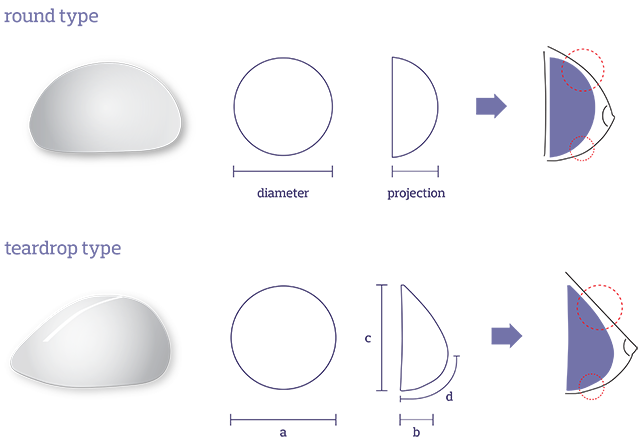
➔ Round Breast Implants
- A round implant provides symmetrical fullness and enhanced upper pole volume.
- They are often chosen for their ability to create a noticeable cleavage or a more augmented appearance.
- Because they are symmetrical, round implants can rotate within the breast pocket without causing any noticeable changes in breast shape, making them versatile for a range of looks.
➔ Teardrop Breast Implants
- Also known as anatomical implants, teardrop-shaped implants mimic the natural slope of the breast, with more volume concentrated at the bottom.
- They are ideal for patients seeking a more natural contour or a subtle lift.
- Since they are asymmetrical, a textured shell minimises the risk of rotation, which could otherwise affect the breast’s shape.
Texture of Breast Implants
Implant texture plays a critical role in implant stability and overall performance. Choosing between smooth and textured implants depends on various factors, including anatomy, implant placement, and desired outcomes.
➔ Smooth Implants
Smooth implants have a sleek surface and move naturally within the breast pocket. They offer a softer feel and are often used when implant movement is not a significant concern. Smooth implants have no association with BIA-ALCL (Breast Implant-Associated Anaplastic Large Cell Lymphoma).
➔ Textured Implants
Textured implants have a rougher surface designed to adhere to surrounding tissues, reducing the risk of implant movement and rotation, especially with teardrop-shaped implants. However, textured implants carry a small risk of BIA-ALCL, with Mentor textured implants showing a risk of approximately 1 in 50,000. The textured surface helps provide stability and reduces capsular contracture.
Breast Implant Placement
The placement of breast implants also determines the final appearance, comfort, and long-term success of the surgery. Implants can be placed in different locations relative to the chest muscle and breast tissue, with each method offering specific advantages.
➔ Subglandular Placement (Above the Muscle)
The implant is positioned directly behind the breast tissue but above the chest muscle. This placement often provides a more prominent, lifted appearance and may involve a shorter recovery time. However, it is typically recommended for patients with sufficient breast tissue to prevent visibility of the implant.
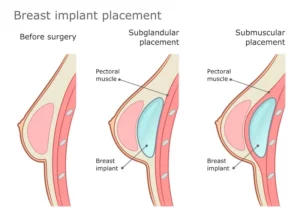
➔ Submuscular Placement (Under the Muscle)
The implant is placed beneath the chest muscle, providing a more natural look, particularly for patients with less breast tissue. This method can help minimize the risk of visible rippling and offers additional soft tissue coverage.
➔ Dual-Plane Placement
A combination of subglandular and submuscular techniques, dual-plane placement positions the upper portion of the implant under the chest muscle and the lower portion under the breast tissue. This approach enhances natural movement and is often used for patients seeking a balance between volume and softness.
Your surgeon will recommend the most suitable placement based on your anatomy, skin thickness, and desired outcomes.
Incisions and Scars after Breast Implant Surgery
The type of incision made during breast implant surgery affects scar location, visibility, and overall healing. Surgeons carefully select the most appropriate incision to minimise scarring and optimise results.
The implant is positioned directly behind the breast tissue but above the chest muscle. This placement often provides a more prominent, lifted appearance and may involve a shorter recovery time. However, it is typically recommended for patients with sufficient breast tissue to prevent visibility of the implant.

- Inframammary Incision:
Made along the crease under the breast, this is the most common technique. It offers direct access to the implant site and allows precise placement. - Periareolar Incision:
Made along the edge of the areola, this technique helps conceal the scar within the natural pigmentation but may not be suitable for all patients. - Transaxillary Incision:
Made in the armpit, this approach avoids visible scarring on the breast but requires specialised surgical expertise.
Scar visibility typically fades over time, and surgeons provide post-operative care instructions to promote proper healing and minimise scarring.
Factors to Consider for Your Best Breast Implants
Choosing the right breast implant involves a careful balance of personal preferences, body anatomy, and lifestyle considerations. Factors such as body proportions, existing breast tissue, and implant texture can influence both the aesthetic outcome and long-term comfort. Working closely with a specialist plastic surgeon ensures a customised approach for optimal results.

The width of your chest, shoulder dimensions, and overall body frame determines how the implant will sit and appear. Matching implant size and profile to your body proportions helps create a natural, balanced look.
Existing Breast Tissue and Thickness
The amount of existing breast tissue and its thickness plays a key role in implant selection. Patients with thick breast tissues can accommodate larger implants, while those with thinner tissues may require smaller or moderate-profile implants to avoid visible rippling or edges. Patients with thinner tissues may benefit from smaller breast implants to avoid visible rippling or edges.
Implant Shape and Profile
Choosing between round or teardrop implants and selecting the right profile (low, moderate, or high) depends on the desired level of projection and overall shape. The right combination enhances natural contours while maintaining proportionality.
Implant Material and Texture
The implant’s material and texture affect the feel, placement stability, and interaction with surrounding tissues. Silicone gel implants often provide a more natural feel, while textured implants help reduce movement in certain cases.
Lifestyle Considerations

Active individuals or those planning significant life changes, such as pregnancy or weight fluctuations, should factor in how these events could affect the long-term outcomes of the implants. Personalised recommendations help ensure longevity and comfort.
How to Choose the Most Suitable Implant Size
- Consultation with a Specialist Plastic Surgeon
Book a consultation with a Me Clinic Specialist Plastic Surgeon to discuss your goals, body proportions, and desired outcomes. They will assess your anatomy and provide expert guidance on the best options. - Sizing and Visualisation Methods
Try on implant sizers during your consultation, look at patient before and afters, or use 3D imaging to visualise different sizes and shapes on your body. These methods help predict your post-surgery appearance. - Consider Key Measurements
Your surgeon will evaluate breast width, implant diameter, and projection needs to ensure a proportional and natural fit that suits your frame. - Evaluate the Long-Term Impact
Take into account potential changes, such as pregnancy, weight fluctuations, or aging, to select an implant size that will provide lasting results.
Common Breast Implant Size Mistakes to Avoid
- Choosing implants based on cup size alone. Cup sizes vary between brands, so relying on them can lead to incorrect sizing. Focus on volume (cc) and dimensions instead.
- Selecting implants that are too large or small for your frame can result in unnatural outcomes. Consider your chest width and body proportions.
- Low, moderate, and high profiles affect projection and shape. Neglecting implant profile will affect the breast augmentation results from matching the desired aesthetic.
- Unclear and inadequate discussions with your surgeon about expectations and concerns will not achieve the best results.
Things to Remember When Deciding on Breast Implants
➔ Larger implants aren’t necessarily the best enhancement
While larger implants can create a more noticeable change, they may not be suitable for every patient. The right implant size depends on individual factors such as body type, existing breast tissue, and personal preferences.
➔ Implant size is not the only factor that determines the final breast shape
Implant size is just one aspect of the final breast shape. Other factors, including implant shape, profile, and placement, play crucial roles in achieving the desired outcome. A comprehensive approach considering all these elements is necessary for optimal results.
➔ You can’t choose any implant size without considering your body type
Selecting the right implant size requires careful consideration of individual factors such as body type, breast tissue, and personal goals. Choosing an implant size that complements your body proportions ensures a balanced and natural appearance.
Conclusion: Finding the Ideal Breast Implant Size
Selecting the ideal breast implant size is a personalised process requiring careful evaluation of body proportions, lifestyle, and aesthetic goals. This is best achieved through a detailed consultation and expert guidance with a skilled practitioner to ensure the best outcome that balances beauty and long-term comfort.
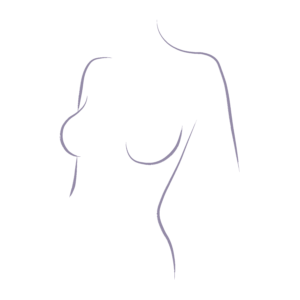
Me Clinic’s Specialist Approach
With over 35 years of experience, Me Clinic’s specialist plastic surgeons focus on tailored recommendations, advanced sizing techniques, and post-operative care. We guide each patient through a customised journey, ensuring safe, proportionate, and natural results.
Take the first step towards your breast implant surgery:
- Call Me Clinic at 1300 852 050 or
- Fill out our online contact form to get in contact.
Breast Implant Size FAQs
What is the most common breast implant size?
Common sizes range between 300cc and 400cc, but the ideal size depends on your body and goals.
How many cc’s increase a cup size?
On average, 150cc to 200cc equals about one cup size increase, but this can vary.
Can implant size be adjusted after surgery?
Yes, but adjustments typically require revision surgery. Saline implants allow for slight volume adjustments during surgery.
Do larger implants increase the risk of complications?
Larger implants can increase risks like visible rippling, capsular contracture, or discomfort, especially in smaller frames.
How do I know if I’ve chosen the right size?
A thorough consultation, sizers, and 3D imaging help ensure your implant size aligns with your body and expectations.
Further reading about breast implants
- Visit the Me Clinic Breast Augmentation Surgery page
- Visit the Breast Lift with Implants page
- Visit the Breast Implant Replacement page
- Visit the Will Medicare Cover My Implant Surgery (Revision, Removal, or Replacement)?
- Read more about how implants can fix uneven breasts
Medical references about breast implants
- Mayo Clinic: Breast implants: Saline vs Silicone
{Visit} - Adams WP Jr, Mckee D. Matching the Implant to the Breast: A Systematic Review of Implant Size Selection Systems for Breast Augmentation. Plast Reconstr Surg. 2016 Nov;138(5):987-994. doi: 10.1097/PRS.0000000000002623. PMID: 27782989.
{Visit}
Surgical Warning: Any surgical or invasive procedure carries risks. Before proceeding you should seek a second opinion from an appropriately qualified health practitioner.
Read more on the Risks of Surgery

